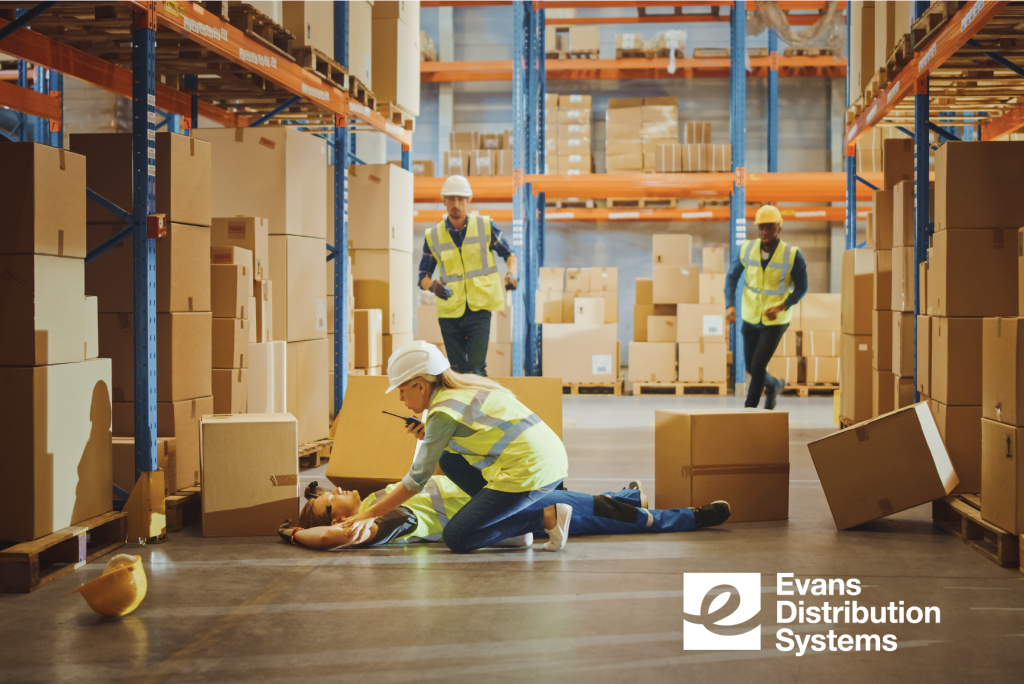Warehousing has some of the highest incidences of workplace injuries. From the equipment to the heavy lifting, warehouses can cause serious and sometimes fatal injuries. Safety and training are critical when it comes to preventing injuries. These are the top warehouse hazards.
- Forklifts – Nearly 95,000 injuries are related to forklifts each year. Forklifts have increased efficiency in the warehouse, but they also pose a major hazard to drivers and warehouse associates. The weight of a forklift, the weight of the load its carrying, and the speed at which it moves all contribute to accidents and injury. Forklifts should be examined before they are put to use and operators should have training on proper stacking and unstacking.
- Loading & unloading containers – Loading and unloading containers can be dangerous if not done safely. Containers need to be inspected for debris, pallet damage, and that it’s properly fastened to the door and the ramp before loading or unloading. Mishandling heavy loads can cause serious injuries.
- Falling objects – Goods have specific stacking requirements to ensure damage is prevented. Any time something is stacked improperly it can bend or cause the pallet to fall over. Stacking guidelines should be followed per the customer’s instructions to avoid falling objects and damaged goods.
- Material handling equipment – Any interaction with machinery can be dangerous. Warehouses are typically equipped with conveyor systems, packaging equipment, pallet jacks, racking systems, etc. All equipment poses a possible threat to injury if not properly used and maintained.
- Exposure to harmful substances – Depending on what is being stored, there is a risk of exposure to harmful substances. Products can become damaged in transit or in storage. Hazardous materials that are classified as harmful and reactionary pose the highest risk of injury in a warehouse. Associates must follow strict safety protocols and review labeling and safety data sheets on how to store those materials safely.
- Slips, trips & falls – Warehouse associates are prone to slips, trips, and falls due to the speed of operations and packaging materials that goods are stored in. Pallets, cartons, boxes, or other material handling equipment could result in a trip/fall. Warehouse leaks and spills can cause associates to slip. Warehouse managers should clear debris and regularly inspect the warehouse.
- Manual lifting – Warehouse associates can experience injuries due to repetitive heavy manual lifting. Back, neck, hand, and arm injuries are the most common.
- Conveyors – Modern conveyor systems are automated and use machine vision to adjust speed to avoid collisions. However, there are risks associated with getting pinched or dragged into a moving conveyor system. Additionally, bulky or unstable items can fall from the conveyor causing injury. Keep hair tied back and avoid loose clothing and jewelry when working by a conveyor. If the conveyor is operating at an uncomfortable speed, slow it down!
- Hazard communication – Hazard communication relates to labeling on the outside of a product. If labeling is missing or it’s inaccurate, it could cause harm to those who are working nearby or mishandling of the goods. Hazardous materials pose the highest hazard communication risk.
- Charging stations – Hazards near charging stations include explosions, burns, and electric shocks if they are not properly monitored and maintained. Associates should use personal protective equipment when charging a forklift. The station should be in an area that is ventilated and within reach of a foam fire extinguisher.
Warehouse hazards can be found in all areas of the warehouse. The Occupational Safety Hazard Association (OSHA) has many tools and resources to reduce workplace injuries. But hazards are known to develop quickly and unexpectedly. Ongoing training and up-to-date safety guidelines are the best methods for protecting associates in a warehouse environment. Evans Distribution Systems has a robust safety and quality management program to address hazards using corrective action reports. To speak to a warehouse safety expert call 1-800-OK-EVANS or write to sales@evansdist.com.

